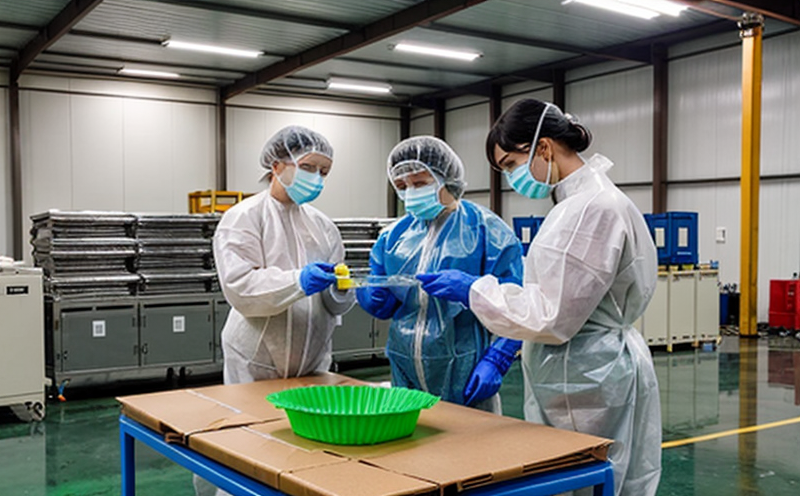ISO 75-1 Heat Deflection Temperature (HDT) Testing
The ISO 75-1 standard specifies the method of determining the heat deflection temperature of plastic materials under defined conditions. This test is crucial for understanding how a material will perform at elevated temperatures, which is critical in various industries such as automotive, electronics, and packaging.
During an HDT test, a small sample of the plastic material is clamped into a holder on a metal rod that is supported by two points. The sample is then subjected to a specified load (typically 14.7 N/mm²) while being heated at a controlled rate. The temperature at which the sample deflects under the applied load is recorded as its heat deflection temperature.
The HDT test provides insights into the thermal mechanical properties of plastic materials, helping manufacturers and engineers to select appropriate materials for their applications. For instance, in packaging design, understanding the HDT can help ensure that the material remains structurally sound at expected operating temperatures.
For a more accurate testing process, it is essential to follow the ISO 75-1 standard meticulously. This includes precise temperature control and consistent sample preparation. The specimen should be cut from the center of a plate or sheet free from defects such as air bubbles or impurities. Properly preparing the specimens ensures that the test results are representative of the material's true properties.
The testing apparatus used in ISO 75-1 HDT testing includes a universal testing machine capable of applying the specified load and maintaining temperature control within ±0.2°C accuracy. The sample holder must be designed to ensure consistent clamping force across all samples, thus minimizing variability between specimens. The heating rate is critical; it should be controlled to ±1°C/min.
The standard specifies acceptance criteria based on the expected performance of the material in its intended application. For example, a higher HDT value indicates better thermal stability, which can be crucial for products that need to function at elevated temperatures without deforming or losing mechanical integrity.
Real-world applications of ISO 75-1 HDT testing include validating the suitability of plastic packaging materials for use in high-temperature environments. This is particularly important for food packaging where the material must maintain its structural integrity during storage and handling. The test also helps in assessing the durability of plastic components in automotive interiors, which are exposed to various environmental conditions.
Understanding HDT values can guide R&D engineers in optimizing materials for specific applications. For instance, if a new polymer is being developed for packaging that needs to withstand higher temperatures, testing it using ISO 75-1 can help identify its limitations and potential improvements.
Benefits
The benefits of ISO 75-1 HDT testing are significant in ensuring the quality and reliability of plastic packaging materials. By accurately determining the heat deflection temperature, manufacturers can:
- Avoid using materials that may deform or lose strength at operational temperatures.
- Ensure compliance with industry standards and regulatory requirements.
- Optimize material selection to balance cost, performance, and safety.
- Reduce waste by minimizing the use of excess material without compromising on quality.
- Enhance product lifespan by ensuring materials can withstand environmental stresses.
In summary, ISO 75-1 HDT testing provides a robust framework for evaluating the thermal mechanical properties of plastic materials. This ensures that packaging designs are reliable and meet both current and future demands in terms of performance and durability.
Industry Applications
| Application | Description |
|---|---|
| Automotive Interior Components | Ensuring materials withstand high temperatures within the vehicle. |
| Food Packaging | Evaluating packaging integrity at elevated storage temperatures. |
| Electronics Enclosures | Testing durability of enclosures in electronic devices under thermal stress. |
| Medical Devices | Assessing the performance of components in sterilization and use environments. |
| Construction Materials | Evaluating the structural integrity of materials used in high-temperature environments. |
| Sports Equipment | Ensuring equipment remains functional under extreme conditions during sports activities. |
| Consumer Electronics | Testing durability and performance of components at elevated operating temperatures. |
The above table highlights the diverse range of applications where ISO 75-1 HDT testing is indispensable. By leveraging this test, industries can ensure that their products are not only functional but also safe and reliable under various environmental conditions.
Quality and Reliability Assurance
ISO 75-1 HDT testing plays a pivotal role in the quality assurance process for plastic packaging materials. It ensures that the materials used meet stringent performance criteria, thereby enhancing product reliability and safety.
In the context of packaging testing, this test helps manufacturers to:
- Detect defects or inconsistencies in material properties early in the development cycle.
- Ensure consistent quality across production batches by validating the process parameters.
- Avoid costly recalls due to product failures caused by suboptimal materials.
- Promote compliance with international standards and regulations, thereby enhancing market access.
The test also aids in R&D efforts by providing insights into material behavior under different thermal conditions. This information can be used to refine formulations and improve the overall performance of packaging materials. By incorporating ISO 75-1 HDT testing into their quality assurance protocols, manufacturers can ensure that their products are robust enough to withstand the rigors of real-world use.





